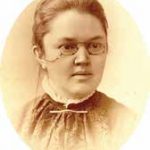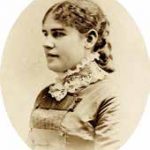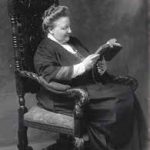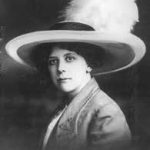Two ‘Boston Marriages’: Katharine Lee Bates & Katharine Coman and Amy Lowell & Ada Dwyer Russell
Katharine Lee Bates and Katharine Coman
In 1882, those who strove to keep the thoughts of other people pure finally succeeded in having Walt Whitman’s Leaves of Grass banned in Boston. Not all Bostonians were pleased, including a woman in her early 20s, a recent graduate of Wellesley College. Still an unknown voice for feminism and social activism, and not yet an influence on American culture, Katharine Lee Bates (1859–1929) joined with other progressive Bostonians to form a local chapter of the International Walt Whitman Fellowship.
Bates returned to Wellesley in 1885 as an Instructor of English. Across her distinguished career, among other accomplishments, she created one of the nation’s first courses in American literature and was the first woman to write a textbook about it. A lifelong social activist and ardent feminist, she worked to improve the condition of women, workers, people of color and immigrants. Her lasting fame, however, was for an entirely different accomplishment.
In the summer of 1893, Bates traveled to Chicago to join her dearest Wellesley colleague, professor Katharine Coman (1857–1915). It was Coman who introduced the college’s first political economy course, became the first female statistics professor in America and later established Wellesley’s Department of Economics and Sociology. Also a passionate social activist, Coman had her students learn about applying economic theory to real economic and social problems by visiting Boston’s tenement houses, factories and sweatshops.
In Chicago, The Two Katharines, as they were called, visited the great World’s Columbian Exposition. Its once gleaming white walls were turning a sooty gray, but Bates remembered it as the “alabaster city” of the future. The couple then traveled under “spacious skies” through “amber waves of grain” to Colorado Springs, where they taught for the summer at the new Colorado College and where Bates was greatly moved by the “purple mountain majesties” of the Rockies.
On their journey home, Bates began putting her thoughts and impressions into a poem she titled “America the Beautiful,” first published in 1895. With music by Samuel Ward, it almost became the country’s national anthem, but in 1931, Congress chose “The Star-Spangled Banner” instead. Its music came from a British drinking song, “To Anacreon in Heaven,” a paean to the ancient Greek poet whose verse often praised the beauty of young men and the pleasures of same-sex lovemaking.
Back in Wellesley, Bates and Coman lived together in what some called a “romantic friendship” or a “Boston marriage,” an emotionally intimate relationship that endured for 25 years. Did they also share a physical affection? No one knows. Most of their personal correspondence was destroyed, although one letter that still exits from early in their affinity describes a deeply felt intimacy: “You are always in my heart and in my longings,” Bates wrote.
After Coman died in 1915, Bates began writing Yellow Clover: A Book of Remembrance, privately published in 1922. She dedicated the book to Coman and its poems clearly and openly describe her feelings toward her life partner and their loving relationship. It is “one of the most anguished memorials to the love and comradeship between two women that has even been written,” wrote author Judith Schwartz, adding that “it is obvious from the yearning desire that glows throughout the poems” that they “were a devoted lesbian couple.”
Amy Lowell and Ada Dwyer Russell
Where Bates led a life of quiet academia, Amy Lowell’s (1874–1925) was one of steadfast flamboyance. She was one of the Lowells, as John Collins Bossidy toasted an alumni dinner in 1910, of “good old Boston/The home of the bean and the cod./Where the Lowells talk only to Cabots,/And the Cabots talk only to God.” Unlike Bates, she never attended college—her family considered it unsuitable for women—but she read widely and was a passionate book collector.
Despite her Brahmin background, Lowell defied almost every convention required by her high social position. She dressed in masculine clothes, wore her hair cropped short, used pince-nez glasses and smoked cigars constantly. Living as an aristocrat and traveling widely, she did not publish her first poetry collection until 1912, the year that she turned 38.
Lowell met Ada Dwyer Russell (1863–1952) in 1912. They lived together as a couple from 1914 until Lowell’s death. Lowell lovingly referred to Dwyer as “the lady of the moon,” although less romantically, she also called her “Pete.” Their so-called Boston marriage was intimate in all ways intellectual, emotional and physical.
One of the founders of the Imagist literary movement and an early adherent of free verse, Lowell eventually wrote more than 650 poems, often about women. Her early work used code words to communicate her sexual feelings and attractions, but over time she became bolder and more emotionally intense. The year after she died, she received the Pulitzer Prize for Poetry for a collection of her writing edited by Russell.
Russell inspired many of Lowell’s later poems. Often described as “the most explicit and elegant lesbian love poetry during the time between the ancient Sappho and poets of the 1970s,” many readers thanked her for capturing the desire, beauty and passion found in “a woman’s love for a woman.” She was “upon the surface of things a Lowell, a New Englander and a spinster,” her contemporary Heywood Broun wrote, but “given one more gram of emotion, Amy Lowell would have burst into flame and been consumed to cinders.”
Bill Lipsky, Ph.D., author of “Gay and Lesbian San Francisco” (2006), is a member of the Rainbow Honor Walk board of directors.













Recent Comments